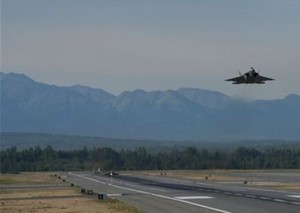
HEADQUARTERS, U.S. ARMY ALASKA, JOINT BASE ELMENDORF-RICHARDSON, Alaska – Fort Wainwright and Joint Base Elmendorf-Richardson were among 30 installations the Army studied in a recent Supplemental Programmatic Environmental Assessment for Army 2020 Force Structure Realignment to evaluate the environmental impacts of potential force reductions of active component soldiers and Army civilian employees.
The Army determined that there are no significant impacts, other than socioeconomic impacts, and that preparation of an environmental impact statement is not required.
Decisions on which units and organizations will be selected for possible reductions have not yet been made. The analysis of environmental and socioeconomic impacts will help force structure decision-makers as they identify the specific units and organizations that may be reduced in the upcoming years.
Although not part of the NEPA process, the Army at Fort Wainwright and Joint Base Elmendorf-Richardson will conduct local community listening sessions in February to receive public input to be considered in the Army’s force reduction decision process. The dates and locations for listening sessions will be announced at a later date.
Due to current budgetary projections, the Army must reduce its active component end strength to a level below that analyzed in the January 2013 Programmatic Environmental Assessment. The supplemental environmental assessment built on the 2013 assessment and analyzed the impacts of a potential reduction of an additional 70,000 Soldiers and associated Army civilians, down to an active component end-strength of 420,000. These reductions are necessary to meet the spending levels required by the Budget Control Act of 2011.
Should these potential reductions become a reality, nearly all Army installations will be affected in some way. The 2013 assessment evaluated 21 Army installations and joint bases where Army stationing changes could result in the inactivation and restructuring of brigade combat teams, or a combined loss of 1,000 or more Army employees during the fiscal year 2013-2020 timeframe.
With the deeper reductions now anticipated, the supplemental assessment evaluated the original 21 installations for greater cuts as well as nine additional installations.
Both the 2013 assessment and 2014 supplemental analyzed potential reductions at the two Alaska installations, as well as 28 other Army installations.
The Army received more than 110,000 comments on the supplemental programmatic environmental assessment from members of the public, members of Congress, state and local officials, Tribal governments, regulators, state and local agencies and officials, special interest groups and nonprofit organizations, civic groups, public service organizations, academia and private businesses.
Many of these comments emphasized the seriousness of potential economic impacts, which is consistent with the Army’s conclusion that the impacts would be significant at most installations. Socioeconomic impacts are of particular concern to the Army because they affect communities around Army installations and joint bases.
The Army’s decision and final supplemental assessment documents may be accessed at: https://aec.army.mil/Services/Support/NEPA/Documents.aspx.
For further information on the supplemental programmatic environmental assessment, please contact the U.S. Army Environmental Command Public Affairs Office at (210) 466-1590 or toll-free 855-846-3940, or email usarmy.jbsa.aec.nepa@mail.mil.
